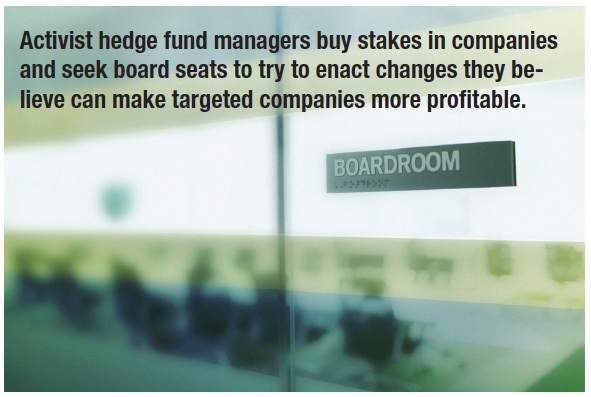Financial headlines in mid-August teemed with accounts of activist investors as Carl Icahn tweeted about his large stake in Apple and demanded the company do an immediate stock buyback; William Ackman quit the board at J.C. Penney as his two-year effort to turn around the struggling retailer ended in failure; and Nelson Peltz disclosed his hedge fund firm bought a chunk of DuPont stock and wanted changes made at the iconic chemical company to boost shareholder value.
The 13D Activist Fund is marketed as an event-driven strategy aimed at generating returns that aren’t correlated to the overall equity market. As of September 5, the fund had gained 28% on an annualized basis and attracted nearly $78 million in assets. “It had $6 million at the end of 2012,” says Squire, founder and principal of 13D Monitor, a research firm focused on 13D filings and shareholder activism.
 Activist hedge fund managers buy stakes in companies and seek board seats to try to enact changes they believe can make targeted companies more profitable. Some critics accuse activist investors of “pump-and-dump” tactics designed to make a quick buck with little regard for whether they potentially weaken companies over the long term.
Activist hedge fund managers buy stakes in companies and seek board seats to try to enact changes they believe can make targeted companies more profitable. Some critics accuse activist investors of “pump-and-dump” tactics designed to make a quick buck with little regard for whether they potentially weaken companies over the long term.
Activist investors aren’t always successful (see Ackman above), but various academic studies indicate they often boost shareholder value beyond the short term. A study released this summer by professors at Harvard, Duke and Columbia analyzed more than 2,000 activist hedge fund interventions between 1994 and 2007. It concluded that activist events, on average, produced a 6% bump in share price in the first month and that the stock maintained those gains during the next five years. The study also found a boost in a company’s return on assets and operating performance during that five-year period.
In years past, some investors have tried to follow the money by tracking the actions of notable activist investors. Now they can do so through the 13D Activist Fund, which bills itself as the only mutual fund using shareholder activism as an investment strategy.
The fund’s name refers to Schedule 13D statements filed with the SEC by investors who acquire more than 5% of a company’s common stock. Launched in December 2011, the fund tracks all 13D filings made each year and invests in companies that the fund manager believes are the targets of the most compelling 13D filings.
Those are defined as filings made by the 10 to 15 activists who have a proven track record, and which are targeted at companies with market caps greater than $1 billion. The fund typically holds between 20 and 40 13D positions.
“We analyze the event, the activist and his track record, and what strategy he is using,” says portfolio manager Ken Squire. “Some strategies tend to have better returns than others.” Equally important, he adds, they analyze a company’s shareholder base to gauge the chances for success because certain types of investors generally don’t vote for activists.
The fund will sell positions after an activist has implemented his strategy and/or exited the stock. (The average holding period for 13D filings is 15 months.)
Expense ratios for the fund’s three share classes range from 1.50% to 2.50%. The investment minimum is $2,500 for retail shares and $1 million for institutional shares. The fund is available on the platforms of Schwab, TD Ameritrade, Fidelity, Pershing and UBS, among others.
Some advisors might abstain from the fund because of its short-term track record. Others might consider it a packaged way to ride the activists’ coattails.
Mutual Fund For Activist Investing
October 2013
« Previous Article
| Next Article »
Login in order to post a comment








